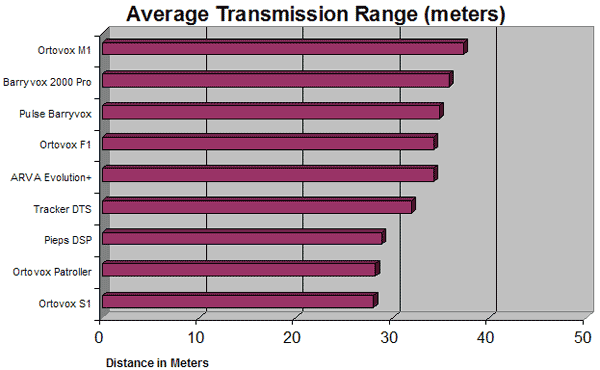Every transceiver "range test" that I've seen measures the distance where an avalanche transceiver can receive a viable signal. (You can read the results of my extensive reception range testing.) This page shows the results of my tests to determine how far transceivers transmit a signal. Rather than testing the distance that you'll be able to locate your partner, these tests indicate how easy it will be for your partner to find you.
I took nine models of avalanche transceivers into the snow-covered Utah mountains. Following the basic testing criteria used in my reception range tests, I placed each transceiver in transmit mode and then measured the distance where an original Pieps DSP and an ARVA Advanced could receive the signal. I measured the distance that each of these avalanche transceivers would lock onto the transmitting signal and beep at least ten times without interruption. I then averaged the two distances.
These transmission ranges look relatively short compared to the reception ranges. That is because I was using an ARVA Advanced (which has a relatively short reception range) and because I required a very strong signal (i.e., at least ten beeps without any interruption, whereas for reception range tests I permitted an occasional missed beep). In the real world, the transmission range will be longer.
The following graph shows how far these transceivers transmitted a viable signal. As with traditional range testing, avoid the tunnel-vision trap of believing that range is the only important criteria—it isn't. Range is certainly important, but the difference won't matter if you are not proficient at searching, probing, and shoveling (get proficient at AvyRescue.com). And as with the reception range tests, variances of 5 meters are probably immaterial.

Since I only performed 18 transmission tests (versus almost 500 reception tests), these results are less conclusive than the reception tests. And it has been a few years since I did these tests so you won't find some of these transceivers in stores. That said, the overall difference of less than ten meters seems relatively small. My tentative conclusion is that the transmitting ranges of the beacons are very similar.
Keep in mind that these ranges were with the antennas in best-case orientation. In perpendicular orientation, the ranges would be reduced (depending on the searching beacon). Most Ortovox transceivers take a unique approach to avoid transmitting on a vertical antenna based on the transceiver's physical orientation (learn about it here).